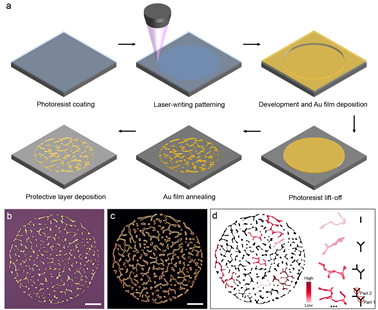Recently, Associate Professor Xie Yong and Professor Chen Ziyu from the Micro-Nano Physics and Applications Research Group of the School of Physics, in collaboration with Researcher Liu Qian from the National Center for Nanoscience and Technology, and Dr. Wang Yanke from Karlsruhe Institute of Technology, Germany, have made important progress in the area of Physical Unclonable Function (PUF) anti-counterfeiting system. The research results were published online in Nature Communications on April 18, 2023 under the title "Random fractal-enabled physical unclonable functions with dynamic AI authentication". PhD Candidate Sun Ningfei is the first author, Xie Yong and Liu Qian are the corresponding authors, and Beihang University is the first affiliation.

Anti-fake labels as the authentication tools of product authenticity face an increasing challenge in security, and researchers are developing new secure anti-counterfeiting methods, continuously pushing the anti-fake science and technology ahead. However, forgery and counterfeiting still result in great losses worldwide, damaging the normal order of the market or even human safety. Thus, developing unclonable security tags based on a new principle would be fundamentally important against the counterfeiting of labels. Physical unclonable functions (PUFs; i.e., physical one-way functions) have become promising identifiers for high-fidelity labels and digital storage. A PUF refers to a physical object with inherent, unique, and fingerprint-like features that are generated via a stochastic and non-deterministic process. The intrinsic randomness ensures sufficient complexity and a high encoding capacity of PUFs, making them nearly impossible to be duplicated. However, the surface textures of current material-based tags often have relatively low physical robustness in practice, such as elastomeric polymer physical aging at high temperature, humidity/water, or oxygen. Therefore, ideal graphical PUF carriers compatible with both high environmental stability and flexibility remain to be developed.

Fabrication and characterization of random fractal-guided PUFs
In this study, Xie Yong et al. develop an efficient anti-counterfeiting system based on the random fractal-network PUFs and an AI authentication used for authenticity identification. Combined with laser lithography, multiple network tags can be simultaneously integrated on the substrate through one-step annealing of the Au film. These Au networks can be flexibly configured in terms of wavelengths and amplitudes by changing the film thickness, which allows them to design the structural complexity on demand. An effective encoding capacity of 10348 is realized, and the capacity value can be raised by recording a larger pattern area and denser network feature. The surface of the Au network is roughened at the nanoscale and thus can generate enhanced electromagnetic “hotspots” under light excitation. The proof-of-concept of SERS-based chemical encoding shows the feasibility of the Au-based PUF in multiple-level encryption. Finally, a convenient (smartphone readout), fast (authentication in 6.36 s), and reliable (zero “false positives” case) deep learning-based authentication system is presented to identify and trace the PUF tags. They also propose a dynamic key database strategy to simplify the tedious training procedure of the deep learning model, which has a lot of potentials to manage a larger PUF key database. Thus, the comprehensive PUF labels that comply with the demands of inherent uniqueness, code reconfigurability, multiple-level security, mass production, and environmental stability (e.g., tolerable in extreme temperature, water/humidity, and abrasion), along with efficient and reliable AI authentication system, will pave a broad avenue toward the applications in next-generation anti-counterfeiting.

Deep learning-based authentication system and anti-counterfeiting strategy
The current PUF design also leaves room for improvement to cover various product fields, such as electronics. Due to the good compatibility with the microelectronic process, the network tag induced by rapid thermal annealing is expected to be seamlessly integrated with electronics and fabricated in great batches on one wafer. Overall, the proposed PUF-based anti-counterfeiting system complies with the demands necessary for commercial applications, and the proposed fractal-guided manufacturing strategy provides promising insights into the design and development of comprehensive PUFs with high code configurability, multiple-level security, environmental stability, and mass production. The technology related to this work has been applied for a Chinese invention patent and already authorized (ZL202210476096.3).
The work was supported by the general program of the National Natural Science Foundation of China, the Beijing Natural Science Foundation, and the double-class construction funds of Beihang University.
Link to the Article:https://doi.org/10.1038/s41467-023-37588-5
Reported by Liu Rui
Reviewed by Li Guangchao
Edited by Ren He
Translated by Wen Li

